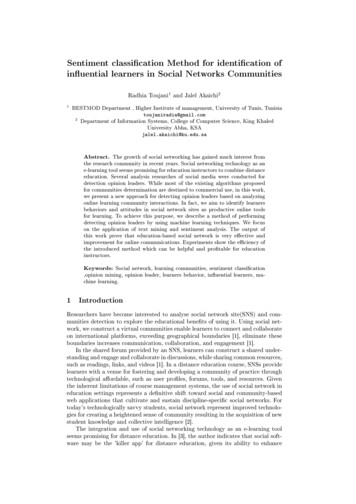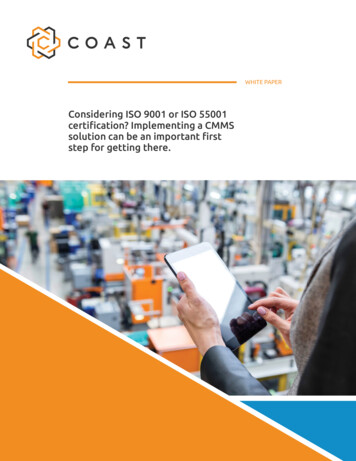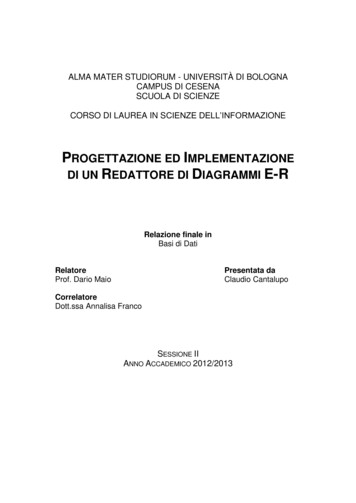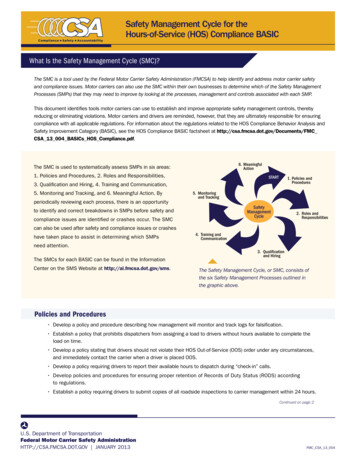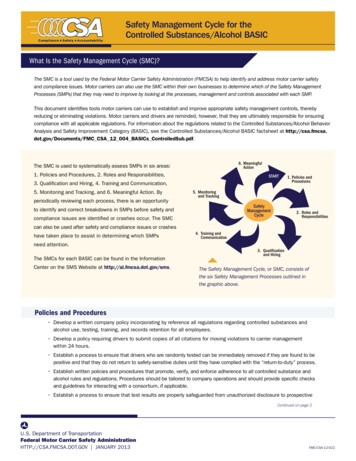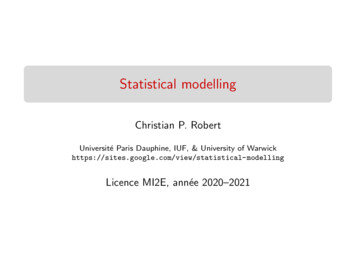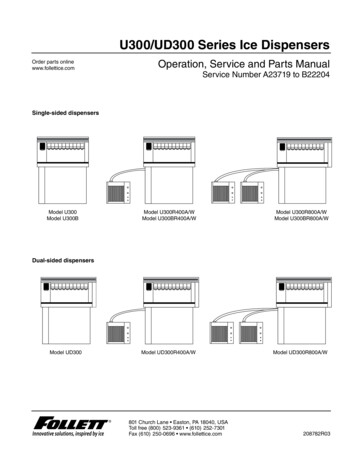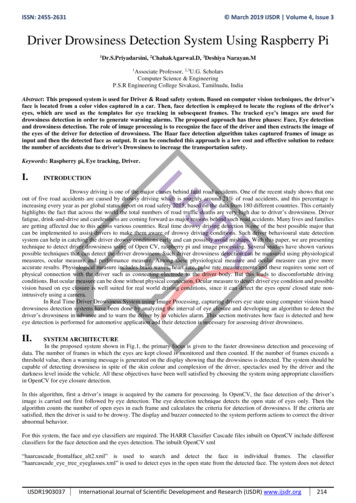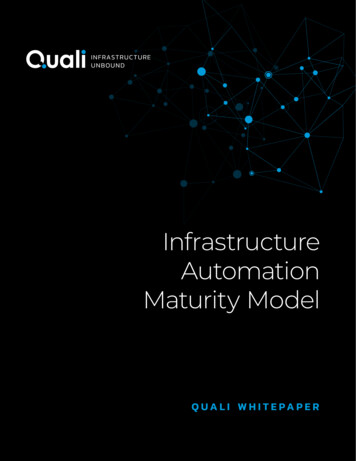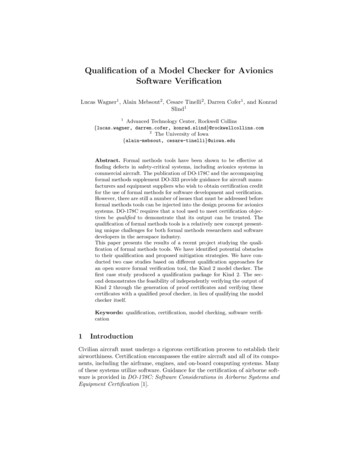
Transcription
Qualification of a Model Checker for AvionicsSoftware VerificationLucas Wagner1 , Alain Mebsout2 , Cesare Tinelli2 , Darren Cofer1 , and KonradSlind11Advanced Technology Center, Rockwell Collins{lucas.wagner, darren.cofer, konrad.slind}@rockwellcollins.com2The University of Iowa{alain-mebsout, cesare-tinelli}@uiowa.eduAbstract. Formal methods tools have been shown to be effective atfinding defects in safety-critical systems, including avionics systems incommercial aircraft. The publication of DO-178C and the accompanyingformal methods supplement DO-333 provide guidance for aircraft manufacturers and equipment suppliers who wish to obtain certification creditfor the use of formal methods for software development and verification.However, there are still a number of issues that must be addressed beforeformal methods tools can be injected into the design process for avionicssystems. DO-178C requires that a tool used to meet certification objectives be qualified to demonstrate that its output can be trusted. Thequalification of formal methods tools is a relatively new concept presenting unique challenges for both formal methods researchers and softwaredevelopers in the aerospace industry.This paper presents the results of a recent project studying the qualification of formal methods tools. We have identified potential obstaclesto their qualification and proposed mitigation strategies. We have conducted two case studies based on different qualification approaches foran open source formal verification tool, the Kind 2 model checker. Thefirst case study produced a qualification package for Kind 2. The second demonstrates the feasibility of independently verifying the output ofKind 2 through the generation of proof certificates and verifying thesecertificates with a qualified proof checker, in lieu of qualifying the modelchecker itself.Keywords: qualification, certification, model checking, software verification1IntroductionCivilian aircraft must undergo a rigorous certification process to establish theirairworthiness. Certification encompasses the entire aircraft and all of its components, including the airframe, engines, and on-board computing systems. Manyof these systems utilize software. Guidance for the certification of airborne software is provided in DO-178C: Software Considerations in Airborne Systems andEquipment Certification [1].
Formal methods tools have been shown to be effective at finding and eliminating defects in safety-critical software [2]. In recognition of this, when DO-178Cwas published it was accompanied by DO-333: Formal Methods Supplement toDO-178C and DO-278A [3]. This document provides guidance on how to acceptably use formal methods to satisfy DO-178C certification objectives. However,there are a number of issues that must be addressed before formal methods toolscan be fully integrated into the development process for aircraft software. Forexample, most developers of aerospace systems are unfamiliar with which formal methods tools are most appropriate for different problem domains. Differentlevels of expertise are necessary to use these tools effectively and correctly. Further, evidence must be provided of a formal method’s soundness, a concept thatis not well understood by most practicing engineers. Similarly, most developers of formal methods tools are unfamiliar with certification requirements andprocesses.DO-178C requires that a tool used to meet its objectives must be qualified inaccordance with the tool qualification document DO-330: Software Tool Qualification Considerations [4]. The purpose of the tool qualification process is toobtain confidence in the tool functionality. The effort required varies based onthe potential impact a tool error could have on system safety. The qualificationof formal verification tools poses unique challenges for both tool developers andaerospace software engineers.Previous NASA-sponsored work has described in detail how one might usevarious formal methods tools to satisfy DO-178C certification objectives [5].This paper presents the results of a subsequent study designed to address thequalification of formal methods tools. The goal of the effort was to interpret theguidance of DO-330 and DO-333 and provide critical feedback to the aerospaceand formal methods research communities on potential pitfalls and best practicesto ensure formal methods tool users and developers alike can successfully qualifytheir tools.We are aware of several commercial tool vendors who have successfully qualified formal methods tools. For example, Polyspace by MathWorks and Astreéby AbsInt both have DO-178C qualification kits available. In the early stagesof this project we helped to organize a Dagstuhl Seminar on Qualification ofFormal Methods Tools [6] to engage both formal methods researchers and certification experts. The seminar included presentations on qualification work forthe Alt-Ergo theorem prover [7], SPARK verification tools [8], and the CompCert compiler [9], as well as experience reports on qualification guidance andefforts in other industries. A good summary of tool qualification requirementsin other domains is found in [10].In this paper we examine the qualification of a model checker for use inverification of avionics software. The success of model checking is largely due tothe fact that it is a highly automated process, generally requiring less expertisethan an interactive theorem prover [11]. One clear strength of model checkersis their ability to return precise error traces witnessing the violation of a givensafety property. However, most model checkers are currently unable to return
any form of corroborating evidence when they declare a safety property to besatisfied. When used to satisfy certification objectives for aircraft software, amodel checking tool would therefore need to qualified.An alternative is to instrument the model checker so that in addition to itssafety claims, it generates a proof certificate, which is an artifact embodyinga proof of the claims. Such a certificate can then be validated by a qualifiedcertificate checker. By reducing the trusted core to the certificate checker, thisapproach facilitates the integration of formal method tools into the developmentprocesses for aircraft software. It redirects tool qualification requirements from acomplex tool, the model checker, to a much simpler one, the certificate checker.The main contribution of this paper is presentation of these two approachesto qualification as applied to the Kind 2 model checker [12]. Section 2 providesa brief overview of the certification guidance for software in commercial aircraft.Section 3 describes the tool qualification process that is used to establish trustin the tools that are used in avionics software development. Sections 4 and 5describe two case studies that illustrate different approaches to qualification:direct qualification of the Kind 2 model checker and qualification of the certificate checker for a proof-generating enhancement of the model checker. Section 6provides conclusions and lessons learned from the project. The complete NASAtechnical report and qualification artifacts are available at [13].2Aircraft Software and CertificationCertification is defined in DO-178C as legal recognition by the relevant certification authority that a product, service, organization, or person complies withits requirements. In the context of commercial aircraft, the relevant certificationauthority is the FAA in the U.S. or EASA in Europe. The requirements referredto are the government regulations regarding the airworthiness of aircraft operating in the National Airspace System (NAS). In practice, certification consistsprimarily of convincing representatives of a government agency that all requiredsteps have been taken to ensure the safety, reliability, and integrity of the aircraft.Certification differs from verification in that it focuses on evidence provided toa third party to demonstrate that the required activities were performed completely and correctly, rather on performance of the activities themselves.The stakeholders in the civil aviation domain (regulators, airframers, equipment manufacturers) have developed a collection of guidance documents defininga certification process which has been accepted as the standard means to complywith regulations. The process includes system development, safety assessment,and design assurance. DO-178C focuses on design assurance for software, andis intended to make sure that software components are developed to meet theirrequirements without any unintended functionality.DO-178C does not prescribe a specific development process, but instead identifies important activities and design considerations throughout a developmentprocess and defines objectives for each of these activities. It identifies five software levels, with each level based on the impact of a software failure on the
Fig. 1. DO-178C certification activities required for Level A software.overall aircraft function. As the software criticality level increases, so does thenumber of objectives that must be satisfied. Depending on the associated software level, the process can be very rigorous (Level A) or non-existent (Level E).Objectives are summarized in a collection of tables covering each phase of thedevelopment process. Figure 1 shows the objectives required for the most criticalavionics software, Level A.One of the foundational principles of DO-178C is requirements-based testing.This means that the verification activities are centered around explicit demonstration that each requirement has been met. A second principle is completecoverage, both of the requirements and of the code that implements them. Thismeans that every requirement and every line of code must be examined in theverification process. Furthermore, several metrics are defined which specify thedegree of structural coverage that must be obtained in the verification process,depending on the criticality of the software being verified. A third principleis traceability among all of the artifacts produced in the development process.
Together, these objectives provide evidence that all requirements are correctlyimplemented and that no unintended function has been introduced.When DO-178C was developed, guidance specific to new software technologies was provided in associated documents called supplements which could add,modify, or replace objectives in the core document. New supplements were developed in the areas of model-based development, object-oriented design, andformal methods, as well as an additional document containing expanded guidance on tool qualification. DO-178C and its associated documents were publishedin 2011 and accepted by the FAA as a means of compliance with airworthinessregulations in 2013.3QualificationGuidance governing tool qualification is provided in Section 12.2 of DO-178C.A tool must be qualified if the following two conditions are met:1. Any of the processes of DO-178C are eliminated, reduced, or automated bythe use of a software tool, and2. The output of the tool is used without being verified.This means that if a tool is used to identify software defects rather than,for example, demonstrating that source code satisfies its low-level requirements(a DO-178C objective), then qualification is not required. Similarly, if a tool isused to generate test cases, but those test cases will be manually reviewed forcorrectness, then qualification is not required.When it is determined that tool qualification is required, the purpose ofthe qualification process is to ensure that the tool provides confidence at leastequivalent to the processes that were eliminated, reduced, or automated by thetool.Tool qualification is context-dependent. If a tool previously qualified for useon one system is proposed for use on another system, it must be re-qualified inthe context of the new system.DO-330 outlines a process for demonstrating a tool’s suitability for satisfyingDO-178C objectives that it is being used to eliminate, reduce, or automate.The qualification process is similar to the software verification process definedin DO-178C. Qualification amounts to accomplishing a set of activities withcorresponding objectives to:– Identify the DO-178C objectives that the tool is eliminating, reducing, orautomating– Specify which functions of the tool are being relied upon– Create a set of requirements that precisely identify those functions– Develop a set of test cases showing that the tool meets those requirements.
3.1Tool Qualification LevelAs in the certification process itself, there are varying levels of rigor associatedwith tool qualification. The Tool Qualification Level (TQL) is similar to the software level in DO-178C and defines the level of rigor required by the qualificationprocess. TQL-1 is the most rigorous, while TQL-5 is the least rigorous.The required TQL is determined by identifying the tool’s impact on thesoftware development process. The impact is characterized by determining theimpact of a error in the tool. DO-178C provides three criteria to characterizethe impact of an error in the tool:Criterion 1. A tool whose output is part of the airborne software and thuscould insert an error.Criterion 2. A tool that automates verification processes and thus couldfail to detect an error, and whose output is used to justify the elimination orreduction of:– Verification processes other than those automated by the tool, or– Development processes that could have an impact on the airborne software.Criterion 3. A tool that, within the scope of its intended use, could fail todetect an error.A code generator in a model-based development process is an example of aCriterion 1 tool. We expect that most formal methods tools will be used as partof the software verification process and will, therefore, fall into Criteria 2 or 3.That is, they will not be used to generate airborne software, but will be used toverify that the airborne software is correct.The distinction between Criteria 2 and 3 depends on exactly which processesthe tool is eliminating, reducing, or automating. For example, if an abstract interpretation tool determines that division-by-zero cannot occur and this is used tosatisfy DO-178C objectives related to the accuracy and consistency of the sourcecode (Objective A-5.6), then the tool is Criterion 3. However, if those results arealso used to justify elimination of robustness testing related to division-by-zero inthe object code (Objectives A-6.2 and A-6.4), then the tool becomes a Criterion2 tool. An unofficial rule of thumb is that when a tool addresses objectives frommultiple tables of DO-178C (corresponding to different development phases), itis likely a Criterion 2 tool.The required TQL is determined by the combination of its impact and theDO-178C software level to which the tool is being applied, as shown in Table 1.In summary, formal methods tools used to satisfy verification process objectives of DO-178C will usually need to be qualified at TQL-5. TQL-4 qualificationwould only be required if the tool is determined to fall into Criterion 2 and it isbeing used in the verification of Level A or B software.3.2DO-330 and Tool Qualification ObjectivesOnce the TQL is determined, the required tool qualification objectives are defined by DO-330. Like DO-178C, these objectives are summarized in a collection
Table 1. Determination of Tool Qualification Level.Software TQL-5TQL-53TQL-5TQL-5TQL-5TQL-5of tables. Table 2 shows the number of objectives to be satisfied in each area forTQL-4 and TQL-5. Note that objectives for a particular TQL are cumulative,so that the TQL-5 objectives are a subset of the TQL-4 objectives.Table 2. DO-330 tool qualification objectives.DO-330 Qualification ObjectivesTQL-4 TQL-5T-0: Tool Operational Processes76T-1: Tool Planning Processes2T-2: Tool Development Processes5T-3: Verification of Outputs of Tool Requirements Process8T-4: Verification of Outputs of Tool Design Process1T-5: Verification of Outputs of Tool Coding & Integ. ProcessT-6: Testing of Output of Integration Process2T-7: Verification of Outputs of Tool Testing2T-8: Tool Configuration Management52T-9: Tool Quality Assurance Process22T-10: Tool Qualification Liaison Process44Total number of objectives3814Table 2 highlights an important distinction between the qualification objectives. The gray rows (qualification objective tables T-1 through T-7) are objectives related to the development processes of the tool itself. The other rows (T-0and T-8 through T-10) are objectives related only to the use of the tool. Thusthere is a clear distinction between the tool developer context and the tool usercontext. Furthermore, TQL-5 qualification only requires objectives from the tooluser context. This means that TQL-5 qualification is significantly simpler thanTQL-4 because it does not require information about how the tool was developed. If a tool was built by a third party, TQL-4 qualification may be difficultto achieve. In particular, since many formal methods tools arise from academicresearch activities, the artifacts required for TQL-4 qualification may not beavailable.Another interesting point is that tool qualification is always performed inthe context of a particular aircraft development effort. This means that certaintool functions may not be utilized or addressed in a qualification. For example,qualification of a model checker may only need to cover variables of primitive
data types while ignoring composite types such as arrays, records, and tupletypes, if those are not relevant for the given application.Once the proper TQL is determined and the objectives have been identified,qualification is simply a matter of demonstrating that each objective is satisfied.For a TQL-5 qualification, the bulk of this effort is associated with DO-330Table T-0, Tool Operational Processes, and involves defining and verifying ToolOperational Requirements which describe tool capabilities necessary to satisfythe claimed certification objectives.4Case Study: Kind 2 Model CheckerThe first case study describes the activities and artifacts necessary to completea TQL-5 qualification of the Kind 2 model checker based on the guidance inDO-330. Our goal is to provide a concrete example that illustrates the qualification process for a typical formal methods tool and could be used as a pattern byothers. We also identify challenges or lessons learned in the process. The qualification package is available as part of the NASA final report for the project.Kind 2 [14] is an open-source, multi-engine, SMT-based automatic modelchecker for safety properties of programs written in the synchronous dataflowlanguage Lustre [15]. It takes as input a Lustre file annotated with properties tobe proved, and outputs for each property either a confirmation or a counterexample, a sequence of inputs that falsifies the property.This case study is based on earlier work [5] in which various formal methodswere used to satisfy DO-178C and DO-333 objectives for verification of a representative Flight Guidance System (FGS). In one of the examples, the Kind 2model checker was used to verify that a model of the FGS mode logic satisfiesits high-level requirements. This qualification case study extends that work byperforming the activities needed to qualify Kind 2 for accomplishing the certification objectives described in the earlier work.Fig. 2. Verification using qualified Kind 2 model checker.
In this example, the mode logic was expressed as a state machine modelin Simulink Stateflow, and serves as low-level requirements for the source codethat will be generated from it. A Rockwell Collins tool was used to translate thismodel into Lustre for analysis by the Kind 2 model checker. Textual high-levelrequirements for the model logic were manually translated to Lustre and mergedwith the mode logic Lustre model. The overall tool chain is shown in Figure 2.This case study is limited to qualification of the model checker and ignores (fornow) the model translation tools.4.1Need for Tool QualificationIn this case study Kind 2 is being used to automate processes that satisfy theobjectives of Verification of Outputs of Software Design Process (DO-178C TableA-4). This includes, for example:– A-4.1 Low-level requirements comply with high-level requirements.– A-4.2 Low-level requirements are accurate and consistent.– A-4.7 Algorithms are accurate.Furthermore, the outputs of Kind 2 will not be independently verified. Thisestablishes the need for qualification.The required TQL is established by determining the impact of Kind 2 on thesoftware development process. In this context the tool:– Cannot insert an error into the airborne software.– Could fail to detect an error in the airborne software.– Is not used to justify the elimination or reduction of other verification processes or development processes that could have an impact on the airbornesoftware.Therefore, Criterion 3 applies so Kind 2 should be qualified to TQL-5.4.2Tool Qualification ObjectivesThe work performed to satisfy TQL-5 qualification objectives is summarizedbelow:T-0.1 Tool qualification need is established. (Rationale for tool qualificationand determination of the required TQL is described in Section 4.1.)T-0.2 Tool Operational Requirements are defined. Definition of the ToolOperational Requirements (TOR) and their verification in objective T-0.5 arethe key qualification activities. The Tool Operational Requirements identify howthe tool is to be used within the software life cycle process. This objective requiresthe identification of the tool usage context, tool interfaces, the tool operationalenvironment, tool inputs and outputs, tool operational requirements, and theoperational use of the tool. The focus here is on the tool performance fromthe perspective of the tool user and what capabilities the tool provides in thesoftware development process.We have specified 111 TORs that must be verified for Kind 2. These requirements cover:
– The features of the Lustre language used by Kind 2 in this context– Input validation features– Properties that must be correctly analyzed as true or false.Since the requirements will be verified by testing performed on Kind 2, theycover a finite subset of the Lustre grammar. Conservative bounds on the lengthof inputs are established and validated.T-0.3 Tool Executable Object Code is installed in the tool operational environment. Identification of the specific versions of the tool and its dependencies,instructions of how to install the tool, and a record of actually installing the toolare required to meet this objective. Qualification was based on Kind 2 version1.0.1 and the Z3 SMT solver [16] (version 4.4.2).T-0.5 Tool operation complies with the Tool Operational Requirements. Thisobjective demonstrates that the tool complies with its TORs. This objective iscovered in three parts. First, the review and analysis procedures used to verifythe TORs are defined. Secondly, we identify a set of tests, referred to as theTool Operational Test Cases and Procedures, that when executed, demonstratethat Kind 2 meets its TORs. Finally, the results of actually executing the testprocedures within the Tool Operational Environment must be collected.T-0.6 Tool Operational Requirements are sufficient and correct. This objective is satisfied by ensuring that the TORs adequately address the tool usagecontext, the tool operational environment, the input accepted by the tool, theoutput produced by the tool, required tool functions, applicable tool user information, and the performance requirements for the tool.T-0.7 Software life cycle process needs are met by the tool. This objective issatisfied by the review, analysis, and testing results used to satisfy the TORs.Other objectives (T-8, T-9, T-10). Tool configuration management,quality assurance, and qualification liaison process. Most of the data requiredby these objectives are highly dependent on the context and the processes ofthe applicant organization and can only be meaningfully defined for an actualsoftware development and tool qualification effort.4.3ResultsThe purpose of this qualification package was to provide a complete case studycontaining a detailed set of tool operational requirements and test procedures.It is anticipated that this qualification package contains all of the necessaryinformation such that it could be used within an avionics certification effort. Nobarriers were found that would prevent qualification of Kind 2.One interesting result from the Tool Qualification Liason process is T-10.4Impact of Known Problems on TORs. During verification of the TORs, someerrors were identified.These have either been corrected or will be corrected inthe near future. However, such errors do not preclude use of the tool in certification activities, as long as the impact and functional limitations on tool useare identified.
The qualification package and results were reviewed by certification expertsat Rockwell Collins and determined to meet the requirements of DO-330. Successfully using it would require an applicant to provide detailed information tosupport the tool qualification objectives from Table T-8, T-9, and T-10, whichare specific to an organization’s configuration management, quality assurance,and certification practices respectively. We expect that it could be used as thestarting point for tool qualification in an actual avionics software developmenteffort or as a pattern for qualification of another tool.5Case Study: Proof-Generating Model CheckerThe second qualification case study is based on a proof-generating version ofthe Kind 2 model checker that is supported by a separate proof checker [14]. Inthis approach, the proof checker verifies the output of the model checker. Thisremoves the need to qualify a complex tool (the model checker) and insteadrequires qualification of a much simpler one (the proof checker). By reducingthe trusted core to the proof checker, we may be able to reduce the qualificationeffort required and enhance the overall assurance.This case study is based on the same software development context as thefirst, and involves using the model checker to satisfy the same certification objectives for verifying the FGS mode logic. The qualification package developedfor the proof checker tool is available as part of the project final report.5.1Development of a Proof-Generating Version of Kind 2For this effort we have used the SMT solver CVC4 [17] with Kind 2. CVC4 isa solver for first-order propositional logic modulo a set of background theoriessuch as integer or real linear arithmetic. Our work relies heavily on the proofproduction capabilities of CVC4. A unique aspect of CVC4 proofs is that theyare fine grained. This means they are very detailed and checking them is onlya matter of carefully following and replaying the steps in the proof certificate.In contrast, proofs produced by other solvers require the final proof checker toperform substantial reasoning to reconstruct missing steps.The proof checker which was qualified in this case study, named Check-It, isan instantiation of the Logical Framework with Side Conditions (LFSC) proofchecker [18]. The resulting tool architecture is shown in Figure 3, which includesboth the unqualified Kind 2 model checker and the qualified Check-it proofchecker.Kind 2 is used to generate two separate proof certificates:– A proof certificate (PC) for safety properties of the transition system corresponding to Lustre model being verified.– A front-end certificate (FEC) that provides evidence that two independenttools have accepted the same Lustre input model and produced the samefirst order logic (FOL) internal representation.
Fig. 3. Verification using Kind 2 and a qualified proof checker.The PC summarizes the work of the different analysis engines used in Kind2. This includes bounded model checking (BMC), k-induction, IC3, as well asadditional invariant generation strategies. In practice it takes the form of a kinductive strengthening of the properties.This intermediate certificate is checked by CVC4, from which we extractproofs to reconstruct safety arguments using the rules of k-induction. Proofs areproduced in the language of LFSC.To make the whole process efficient and scalable, certificates are first minimized before being checked. An iterative process takes care of this phase byefficiently lowering the bound k and removing any superfluous information contained within the certificate.The FEC is necessary to ensure that the proof in the PC is actually aboutthe input model provided. Without this step, it is possible that the (unqualified) model checker could produce a valid PC that is unrelated to the inputmodel. The FEC is generated in the form of observational equivalence betweentwo internal representations generated by independently developed front ends.In our case, the two front ends are Kind 2 itself and JKind, a Lustre modelchecker inspired by Kind but independently developed by Rockwell Collins [19].Observational equivalence between the two FOL representations is recast as aninvariant property. Checking that property yields a second proof certificate fromwhich a global notion of safety can be derived and incorporated in the LFSCproof.The trusted core of this approach consists of:– The LFSC checker (5300 lines of C code).– The LFSC signatures comprising the overall proof system in LFSC, for atotal of 444 lines of LFSC code.– The assumption that Kind 2 and JKind do not have identical defects thatcould escape the observational equivalence check. We consider this reasonablesince the tools were produced by different development teams using differentprogramming languages.
5.2Qualification of Check-ItThe approach of using a qualified tool to check the results of an unqualifiedtool is not unpreced
DO-178C requires that a tool used to meet its objectives must be quali ed in accordance with the tool quali cation document DO-330: Software Tool Qual-i cation Considerations [4]. The purpose of the tool quali cation process is to obtain con dence in the tool functionality. The e ort required varies based on
